Thailand, the Land of Smiles, has firmly cemented itself as one of the most popular tourist destinations on the planet.
With 39 million people visiting the Southeast Asian nation in 2019, the word is well and truly out on just how magical Thailand really is.
The international tourism industry in Thailand really started back in the 1970s, when travellers made their way here along the old ‘Hippie Trail’ from England.
This paradise was their reward after months of tough overlanding, with swaying palm trees, white-sand beaches, hospitable locals, and some of the tastiest food imaginable.
Today the magic is still alive and well in Thailand, and with so many incredible places to visit, it’s the kind of place you can visit again and again and always discover something new.
Locals welcome tourists with open arms, excited to show their local culture and customs to visitors and to improve their own livelihoods through businesses that cater to international travellers.
The impacts of the tourism industry on Thailand haven’t always been positive though, and with the growing number of people coming every year, there has been a number of issues arise.
As a responsible traveller, it’s important for us all to do our part to protect the countries we visit, including the environment, culture, local community, and wildlife.
READ MORE: Don’t miss our comprehensive guide to sustainable tourism.
Table of Contents
Sustainable Tourism in Thailand – The Ultimate Guide
We’ve been fortunate enough to spend almost an entire year travelling and living in Thailand, and it is honestly one of our favourite countries in the world.
As part of our travels we’ve seen the best, and worst, of tourist behaviour and impacts here, which is why we have published this guide.
We are big advocates for sustainable tourism, and we are pleased to see it’s not just a global trend, but a movement that even the Thai government is taking very seriously.
Before you decide to travel to the Land of Smiles, make sure you read up on these tips and ideas on how to travel to Thailand responsibly.
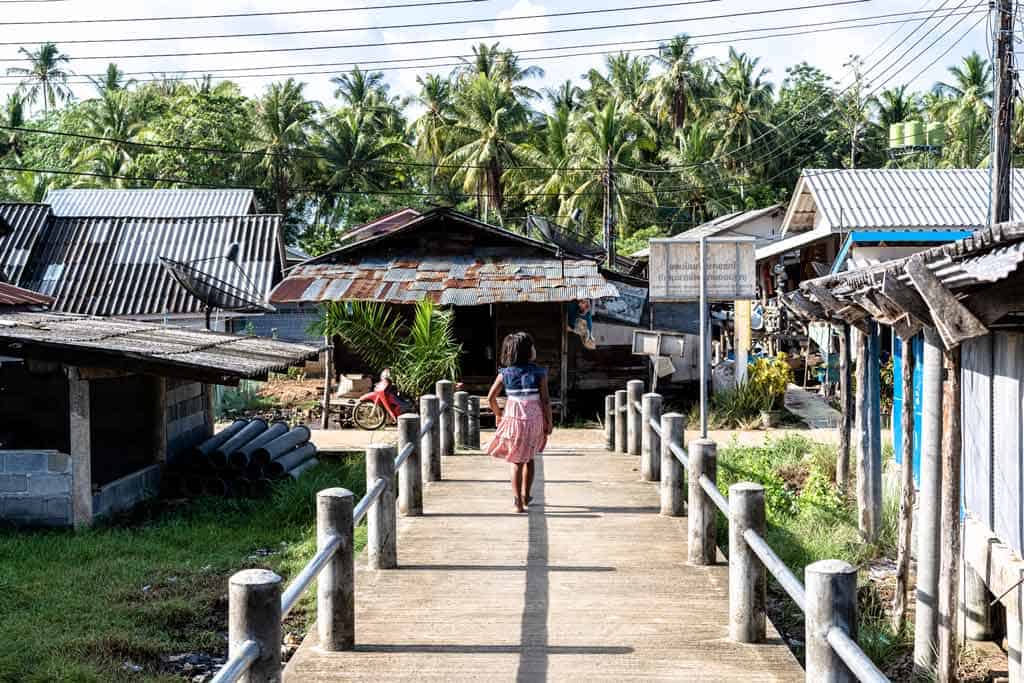
The Thai Government’s Own Initiatives
In recent years, the Thai government has seen the impacts of the tourism industry, both positive and negative, and has taken a firm stance to improve sustainability throughout the Kingdom.
It’s uplifting to see a government take what may seem like drastic measures to protect their own environment and local culture, and they have become an example to other Asian nations on how sustainable tourism can really be beneficial.
To read more about this, be sure to check out their dedicated website, 7 Greens.
Here are some examples of what they have done in recent years.
Closing Popular Tourist Destinations
Every year the Department of National Parks, Wildlife and Plant Conservation takes extreme measures to protect the most heavily-visited regions of the country by closing them to tourists.
The biggest example of this when Thailand closed Maya Bay, the island close to Koh Phi Phi, which was made famous when featured in the movie The Beach.
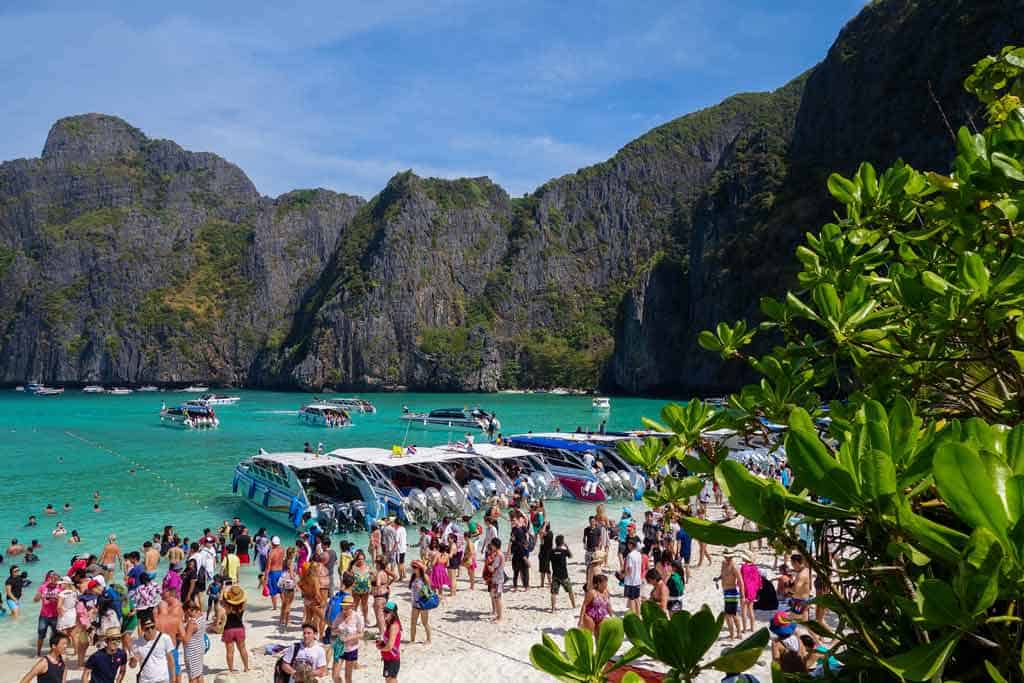
Over the years Maya Bay became a victim of its own beauty, with millions of tourists flocking into the narrow cove.
The huge numbers of people resulted in severe damage to the ecosystem, with marine life disappearing, waters becoming polluted and trash piling up.
The government closed access to the island in June 2018, citing the need for it to recover.
They are doing similar things to other popular destinations, often during the rainy season when the environment is at its most fragile, and are seeing excellent results.
No Smoking
On some of the most popular beaches in Thailand, the government has completely banned smoking.
They saw the damage cigarettes were doing, with tourists and locals leaving their butts on the ground, and the smoke causing health issues, and decided to remove the problem completely.
This ban is in effect in Phuket, Phang-nga, Krabi, Trang, Samui, Hua Hin, Cha-am, Chon Buri, Rayong and Trat.
‘No Foam No Plastic’
The other big initiative that the Thai government and local businesses have introduced as of August 2018 is banning single-use plastics from all 154 national and regional parks around the country.
And in 2020 Thailand took it a step further by banning single-use plastic bags, with an aim to have these completely eradicated from all stores by 2021.
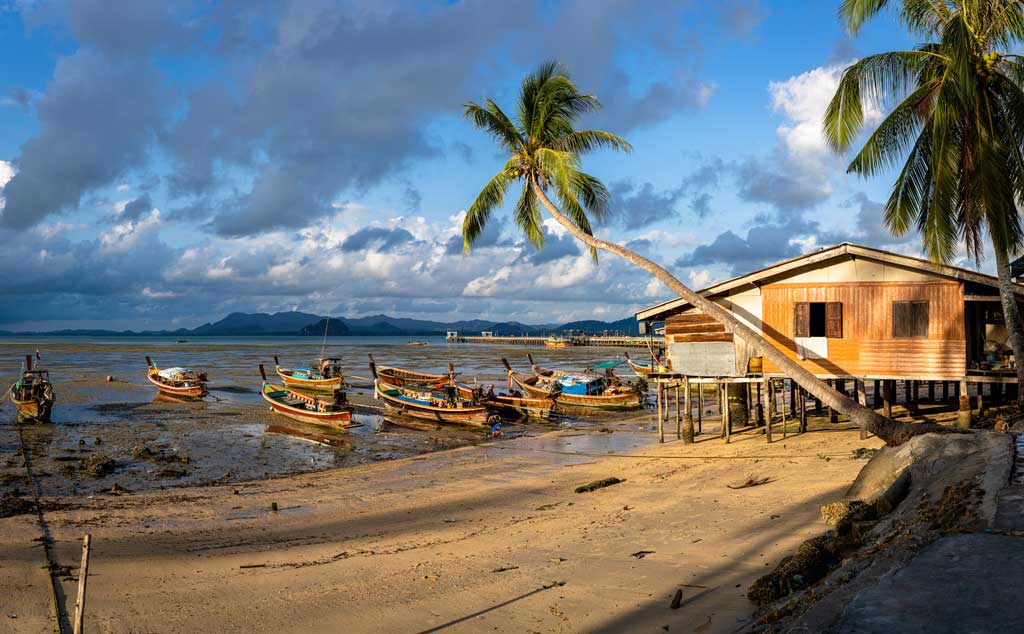
Ecotourism in Thailand
What is ecotourism? It is defined as: “tourism directed towards exotic, often threatened, natural environments, intended to support conservation efforts and observe wildlife.”
The concept of ecotourism in Thailand isn’t new, but it was always more of a niche offering compared to the typical resort-style travel that many visitors would do.
Today it is a different story though, and more and more businesses are incorporating ecotourism practices into their products.
You can find a variety of conservation projects in Thailand, focused on sustainable travel and environment and wildlife protection.
Environment Conservation Projects
Here are some of our favourite conservation projects focusing on sustainable travel and the environment:
New Heaven Reef Conservation
Based on the spectacular island of Koh Tao, the New Heaven Reef Conservation, this organisation runs marine-specific courses and projects to protect and study the underwater world in the Gulf of Thailand.
Trash Hero
Trash Hero is an initiative that has gone global but was started right in Bangkok.
According to their website, “TRASH HERO is an energetic, volunteer-led movement that drives change within communities around the world, motivating and supporting them to clean and prevent plastic waste.”
So next time you’re in Bangkok, get in touch with them and join the crew for a waste clean-up.
Wildlife Conservation Projects
We’ll go into the wildlife activities further below in the article, but there are some excellent wildlife conservation projects that you can support when practicing sustainable travel in Thailand.
Elephant Nature Park
By far the best elephant sanctuary and conservation project in Thailand, Elephant Nature Park has been committed to protecting elephants since 1998.
Founded in Chiang Mai by the incredible Thai lady, Lek, ENP now has a number of projects around the country, as well as in Cambodia and soon Myanmar.
You can visit Elephant Nature Park for a day, or even volunteer for up to a month.
The Soi Dog Foundation
The Soi Dog Foundation has made it their mission to protect the thousands of stray dogs that are found all over Thailand and to end the dog meat trade in Southeast Asia.
You can help out by donating to their cause, or volunteering when in Bangkok or Phuket.
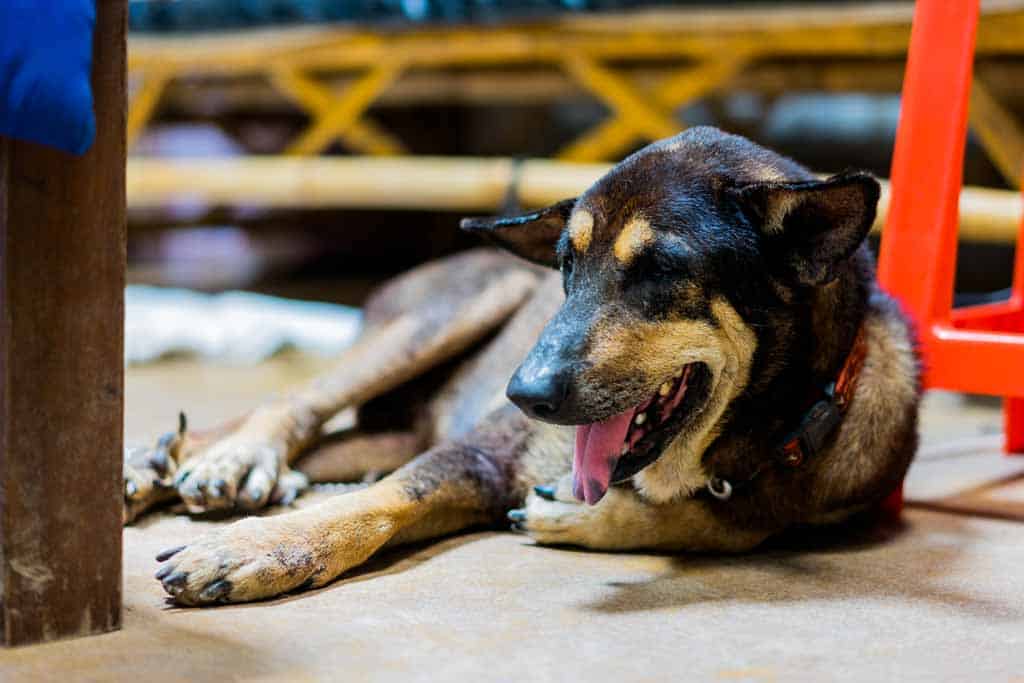
The Gibbon Project, Phuket
The Gibbon Project is a fantastic conservation initiative that can be found in the popular resort town of Phuket.
The project rescues and rehabilitates these gorgeous, yet endangered, monkeys and then reintroduces them into protected natural habitats.
You can visit their facility in Phuket if you book ahead.
Wildlife Activities
Thailand is home to several impressive wildlife species, which many tourists naturally want to see when they travel to the country.
In general, the best way to stay responsible when it comes to travelling in Thailand is to not take part in any activity that exploits wildlife.
Elephants
Perhaps the main animal people would like to see in Thailand is an elephant.
These beautiful, intelligent, and enormous creatures live deep in the jungles of Thailand and have been a part of local culture for centuries.
But did you know there is an estimated 3800 captive elephants in Thailand, with perhaps less than 1000 in the wild?
One popular activity is to ride an elephant in Thailand, however, this is actually a very irresponsible thing to do for several reasons.
- An elephant, while very strong, has not evolved to carry weight on its back.
- The process of ‘breaking’ an elephant in order for it to be safe around tourists is extremely distressing.
- Elephants used for riding are often overworked and malnourished in order to maximise their profit margin.
It is extremely important that you never ride an elephant, no matter how much you think it would be ‘fun’ or ‘cool’, and never visit an elephant show where they are forced to perform tricks.
Instead, it is much more wholesome to visit a reputable elephant sanctuary where the animals have been rescued and placed in a protected natural environment to live out their lives the way they were meant to.
Spending time around an elephant is an experience you will never forget, and is something you absolutely should do while visiting Thailand, but please do so in an ethical and responsible way.
We highly recommend the following sanctuaries:
- Elephant Nature Park in Chiang Mai
- Surin Project in Surin
- Elephant Haven in Kanchanaburi
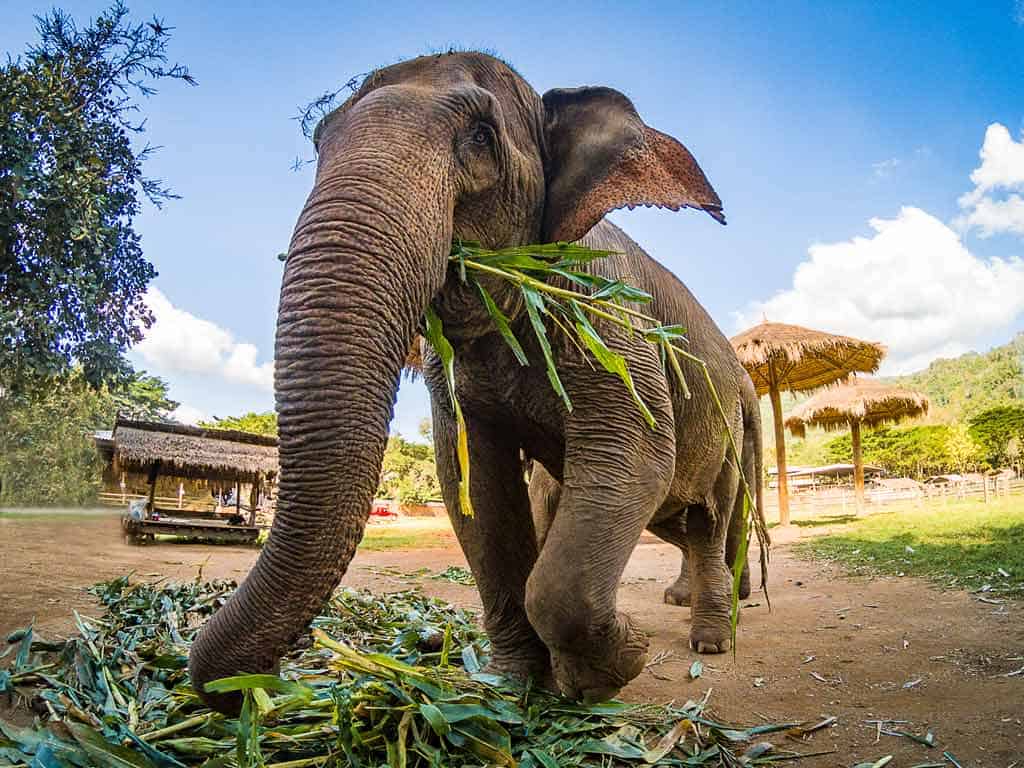
Tigers
Another popular attraction for first-time visitors to Thailand are the ‘Tiger Temples’ that offer the chance to get up close and personal with a tiger.
As tempting as it is to get your selfie with a tiger, the truth is that what happens behind the scenes at these places doesn’t always have the tigers’ best interests at heart.
A tiger sanctuary in Kanchanaburi was raided in 2016 due to suspected trafficking and illegal breeding, and the Thai government ultimately seized all the animals that were on the property.
So where can you see a tiger in Thailand?
The World Wildlife Fund estimated that there are only 189 tigers in the wild, so unfortunately the chance of seeing one in the wild is very slim.
It’s not all bad news though. Tigers have recently been caught on tracking cameras in the far north of the country, showing that they are starting to make a comeback thanks to the Thai government’s restrictions on poaching and illegal logging.
There are currently no ethical tiger sanctuaries in Thailand.
Monkeys
There are five different types of monkeys in Thailand, and you will find them everywhere.
If you head to the south of the country they are extremely prominent around the islands, especially in places like Krabi.
Seeing them is always quite exciting, however, just like elephants, many macaques in Thailand have been captured and forced to perform tricks and shows for tourists.
Don’t support these shows, and instead hope to see some monkeys in the wild.
READ MORE: Be sure to read our comprehensive guide to travelling Thailand here.
Eco-friendly Accommodation in Thailand
Thailand has every style of accommodation you could ever imagine, from world-class 5-star resorts to basic bamboo shacks.
When it comes to choosing the level of luxury you want, the limit really is only your wallet.
However, on an eco level, the 5-star resort might be worse than the bamboo shack when it comes to looking after the environment.
This can be for a number of reasons, whether it is due to overtourism, large resorts not being able to control their environmental footprint properly, or putting an emphasis on profits.
And the larger the resort, the larger the impact. That’s why it’s important to look for eco-friendly accommodation when you practice sustainable travel in Thailand.
So what makes a hotel or guesthouse eco-friendly?
We wrote a dedicated post on how to choose sustainable accommodation here, but let us give the main pointers again.
This is what a hotel can do to try and focus more on sustainable travel:
- Limiting energy consumption
- Limiting water consumption
- Reducing waste production
- Using renewable energy
- Promoting environmental education
- Contributing profits to green charities
- Using recycled and locally-sourced products
It seems pretty straightforward, and in all likelihood, you’re probably doing a lot of these things in your own home as well.
But when it comes to the hotel industry, it’s easy to do what is known as ‘greenwashing’, where they claim to be eco-friendly by doing a few things like telling guests to watch their water use, but then don’t do anything else on their end.
We recommend you give the article above a good read to get a better idea of this, but for now let us showcase some of the best eco-friendly hotels in Thailand.
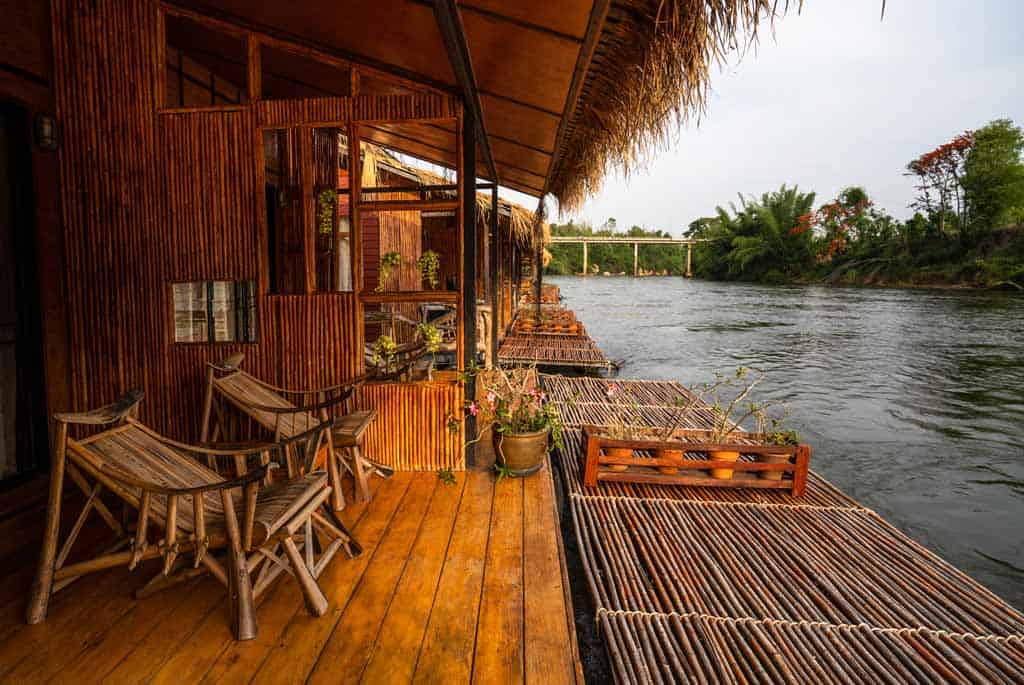
Bangkok Tree House
Located in a literal jungle deep in the urban jungle of Bangkok, the Bangkok Tree House is one example of an accommodation that is not only doing their part to protect the environment, but also providing a unique experience for their guests.
Their ‘nests’ live high in the canopy, and you’re sure to fall in love with what they have built.
Bangkok Tree House is also fully committed to being green, and they’ve minimised their carbon footprint in every way possible.
They also use vertical gardens to grow their food and vegetables, and recycle or reuse all of their materials.
Soneva Kiri – Koh Kood
The island of Koh Kood is the go-to destination for lovers of luxury, and the swaying palm trees over powder sand beaches is a real drawcard.
If you do visit, we recommend staying at the number 1 eco-resort on the island – Soneva Kiri.
This is the one place where you can splurge out for an unparalleled experience (each villa comes with private infinity pools and a personal butler), knowing that your money is supporting community-based tourism and protecting the environment.
Soneva Kiri puts their profits towards coral restoration projects and supporting local communities, raising close to $6 million for people in need.
They are also completely carbon neutural and a pillar of sustainable travel.
Rabeang Pasak Treehouse Resort – Chiang Mai
If you’re travelling on a budget but still want to do what you can to support sustainable travel and ecotourism in Thailand, it’s worth checking out Rabeang Pasak Treehouse Resort in Chiang Mai.
The property is made up of sustainably-built treehouses just outside of the city, set in a stunning forest landscape with a focus on minimising their footprint.
The eco friendly facilities are basic, but you’ll fall in love with the simple way of living surrounded by the sound of nature.
Culture and Customs – Respecting the Locals
You may feel that sustainable tourism is all about protecting the environment and wildlife, but there is another element that needs to be considered – the human element.
One of the big rewards of travelling the world is having the chance to learn about new cultures, and in Thailand, the culture is one of the most fascinating you can encounter.
The predominantly-Buddhist nation is built on the ethos of kindness, hospitality and respect, and as soon as you touch down here for the first time you’ll know exactly what we mean.
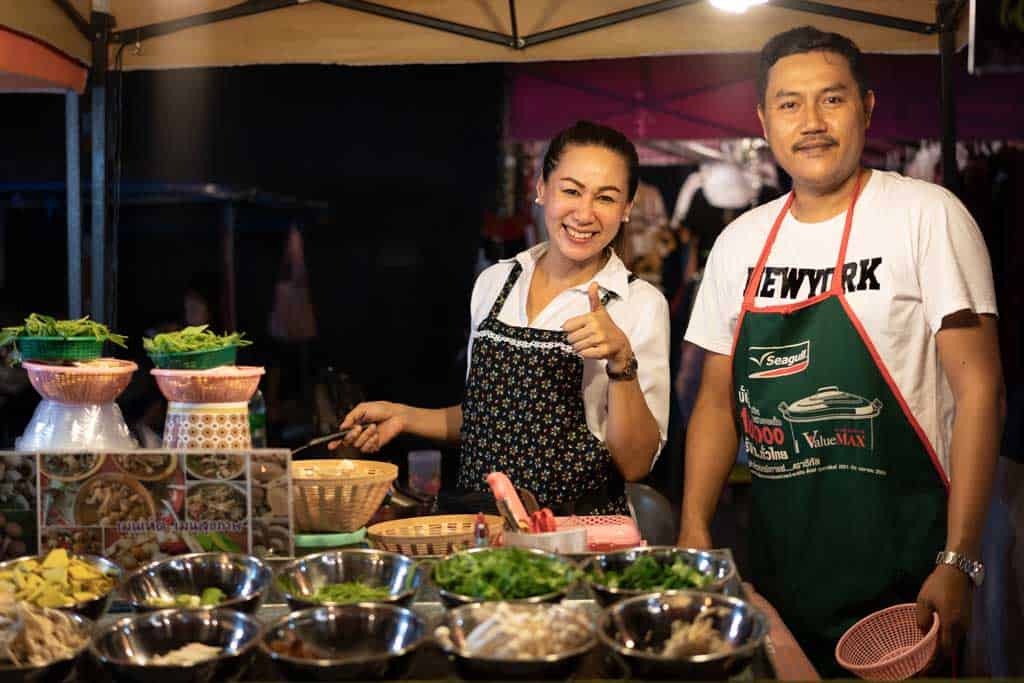
People bow (known as wai) to greet to each other with a warm “Sa wa dee”, and they finish each sentence with “ka” or “krup”, depending on whether they’re addressing a male or female, as a sign of courtesy and respect.
A visit to a Buddhist temple also gives a unique insight into the beliefs of the Thai people, and one of the best things you can do is simply sit and watch as they pray and make their offerings to get a better understanding into what Buddhism is about.
It’s important to open your heart and mind to these local customs when you travel to Thailand.
Things may be different to what you’re used to at home, but isn’t that the joy of travelling?
There are a number of unique customs that Thai people have that you should keep in mind and respect when visiting the country.
Here’s a breakdown of the most important ones.
Always Show Respect to the King
The King of Thailand is the most revered person in the country, and Thai people love him dearly.
Do not show any disrespect towards him or the Royal Family (in fact it is against the law to do so) by talking negatively about them.
Anything with their likeness on it is also considered important, such as the local money that has the King’s portrait printed on it, so be careful not to cause any damage to this.
As an example, if you drop a note, do not step on it with your feet to stop it from blowing away, as this is considered disrespectful. Instead, pick it up with your hand.
Do Not Turn Your Back Towards Buddha
When visiting a Buddhist temple, always face the Buddha and don’t turn your back towards him.
The proper way to exit a temple is to walk backwards to the door, turn at the last minute.
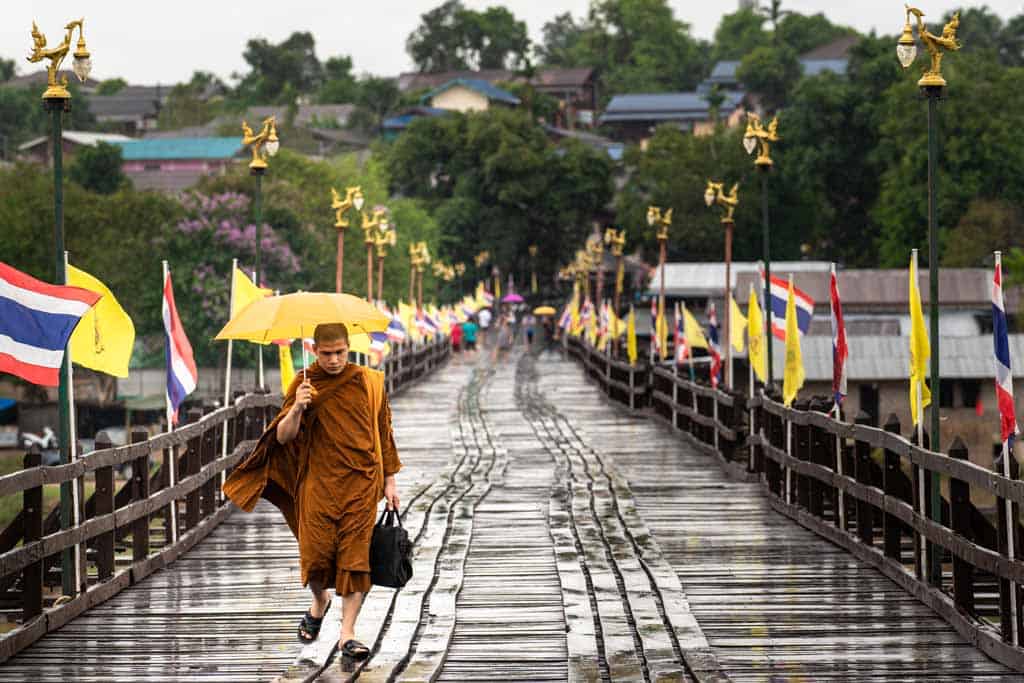
Watch Where You Point Your Feet
The feet, being the lowest part of the body, are considered to be dirty, and as such make sure you never point your feet towards somebody on purpose.
That is why Thais tend to sit on their feet or cross their legs, rather than sitting with their feet spread out in front of them – to make sure they don’t point them at another person, or Buddha.
Do Not Touch a Person’s Head
The opposite of the feet, a person’s head is considered to be the most important part of the body, and it is disrespectful to touch somebody’s head.
Show Respect to the Monks
When you see a Buddhist monk, whether it’s in a temple or out in public, always show respect to them.
Ways you can do this are to bow when they walk past, try to keep your head level below theirs (remember, it’s the most important part of the body), and giving up your seat for them.
Dress Modestly
Thai people are very modest and can be somewhat conservative. So you should make sure you always dress appropriately.
As an example, when you’re at the beach it’s ok to wear swimwear, but when you leave the beach make sure you cover up.
Do not wear a bikini or no shirt into a store or restaurant, and don’t walk around town showing excess skin, as this may make some locals feel uncomfortable.
As a good rule of thumb, look around at what the locals are wearing. If they’re not in a bikini, you shouldn’t be either, no matter how hot it is.
Cover-Up in Temples
As an extension of dressing modestly, if you are entering a temple, make sure you wear appropriate clothing.
This includes covering your shoulders (ladies can usually get a sarong at the door to do so).
Do Not Raise Your Voice
Thai people hate confrontation and raising your voice and yelling is one of the most disrespectful things you can do.
Even if you’re feeling frustrated at a lack of communication, or feel as though you may be getting taken advantage of in a transaction, keep your cool and speak in a normal tone.
You will achieve nothing by screaming at somebody, and you will lose all respect.
Always be polite, and the locals will be the same to you.
Try to Learn a Few Thai Words
The Thai language is notoriously difficult to learn for English-speakers, and nobody expects you to become fluent in Thai during a holiday.
But locals will be very appreciative if you at least put a little bit of effort into speaking their own tongue.
Just pick up the basics, such as hello, thank you, how much, goodbye, and perhaps try to count to 10.
Barter, but Don’t be Extreme
If you are shopping for souvenirs in a market, it’s normal to barter, but don’t go over the top and try to negotiate an extremely cheap price.
You might think it’s a game, but remember that the locals need to make a living too, and a few dollars here and there will help them out a lot more than it will you.
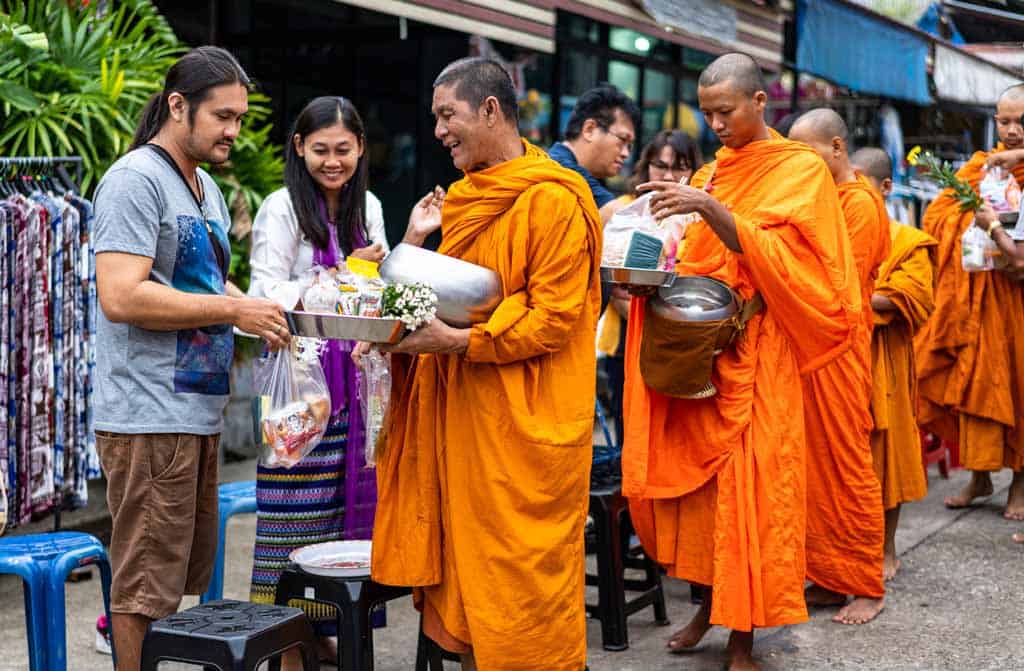
Unethical Attractions Involving People
On an ethical level, there are a number of tourist activities and attractions that exploit the wonderful local people of Thailand.
As a general rule of thumb, be very cautious about joining any cheap tour that involves a visit to a minority tribe, involves children, and sexual exploitation attractions such as the infamous Ping Pong Shows of Phuket and Bangkok.
These are some of the most important ones to avoid.
Long-Neck Tribes
In the north of Thailand, the famous long-neck tribes from the Karen and Kayan ethnic minority communities have been a unique example of where a tradition has been exploited for tourist reasons.
Many travellers want to come to these remote villages to see the practice of women putting rings around their necks to elongate them.
But what few people realise is that this tradition causes extreme health problems.
In fact, many of these communities have expressed a desire to stop putting themselves through such a problematic modification of their bodies, but there is one reason to continue it – tourist dollars.
If it wasn’t for international tourists spending money to visit their tribes, they would stop the practice and return to their normal lives.
Another issue is that most of the money from these hill tribe tours don’t actually go to the local communities. Instead they are kept by the operators, and the villages make their money by trying to sell handicrafts.
Orphanages
Over the years the concept of ‘voluntourism’ has become popular for many visitors who wish to give back to the communities they are visiting.
While this is a noble idea, and for the most part people’s hearts are in the right place, there are issues with this type of tourism.
The biggest concern is when it comes to visiting orphanages.
Unfortunately there are several children who have been orphaned in Thailand, and it’s only normal to want to help them.
But unless you have experience with child care in these exact environments and are planning to stay for a long time, a day trip to an orphanage isn’t the best way to do this.
Instead the best way to help is to donate money and supplies through reputable charities.
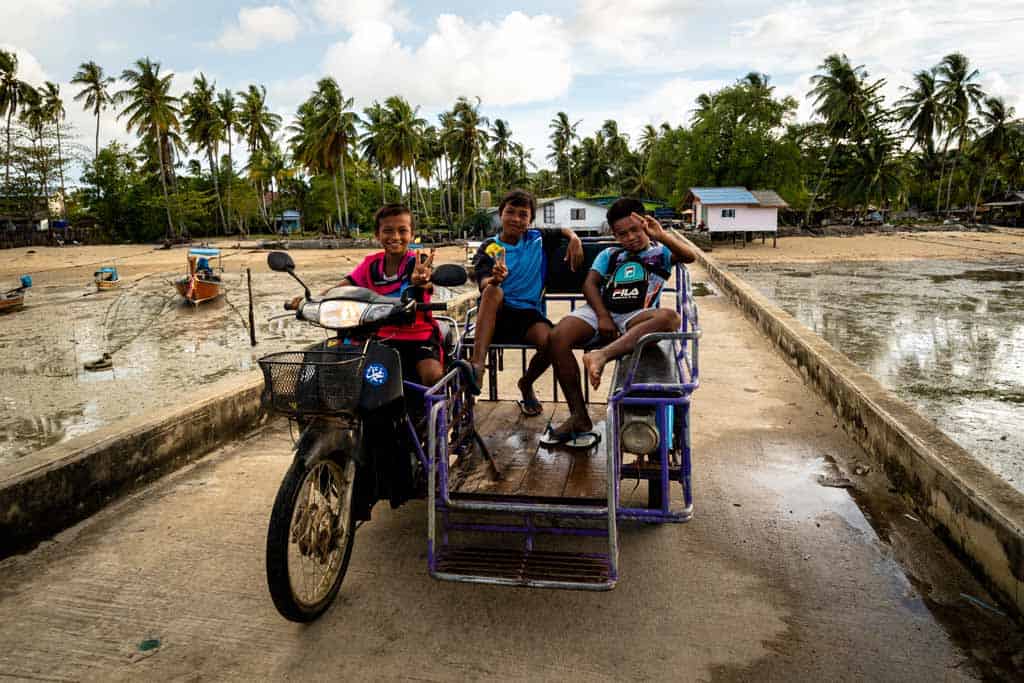
Protecting the Environment
Thailand really is one of the most beautiful countries in the world, and it has almost every type of landscape you could wish for.
When you decide to visit, it’s important to minimise your footprint and protect this spectacular environment.
Here are the best ways to do just that.
Minimise Your Plastic Use
While Thailand is taking steps to remove all single-use plastics by 2021, you can do your part as well by bringing your own reusable items.
Make sure you add these to your Thailand packing list:
- A reusable water bottle. Not only can you usually refill these from large jugs at your accommodation, Thailand also has reverse osmosis machines on almost every city block so you can get drinking water for as low as 1THB per litre.
- A carry bag. Don’t take a plastic bag when you shop, and instead bring your own cloth one.
- Metal cutlery. You’ll most likely be eating a lot of delicious food on your trip, but don’t just always grab the plastic cutlery available. Throw your own in your bag and save on waste.
Do Not Litter
This one is pretty self-explanatory, but you’d be amazed at how many tourists we’ve personally seen throw their rubbish on the ground or off the side of a boat.
Under no circumstance should you ditch your rubbish anywhere but in a bin.
No matter how much of an inconvenience it is to carry until you find one, do not contribute to polluting the earth by being careless.
Take Public Transport Where Possible
Carbon emissions from airplanes and vehicles are quite high around the world, but you can minimise your own carbon footprint in a few different ways.
First of all, don’t take any more flights than you absolutely have to. For example, rather than flying from Bangkok to Chiang Mai, why not take the train?
Second, always go for public transport where possible. Take a public ferry or songthaew instead of renting a private boat or car.
Third, and even better for the environment, walk or rent a bicycle to get around.
Oceans and Marine Parks
Take extra care when spending time in the stunning Andaman Sea and Gulf of Thailand.
Plastic and trash often end up in the oceans, killing marine life and polluting the sea for future generations.
Also try to avoid any overcrowding of popular destinations. The last thing we need is another Maya Bay catastrophe.
Another way you can protect the oceans is to never touch sea life or coral.
This includes standing on reefs when snorkelling or swimming, and not collecting souvenirs from the sea.
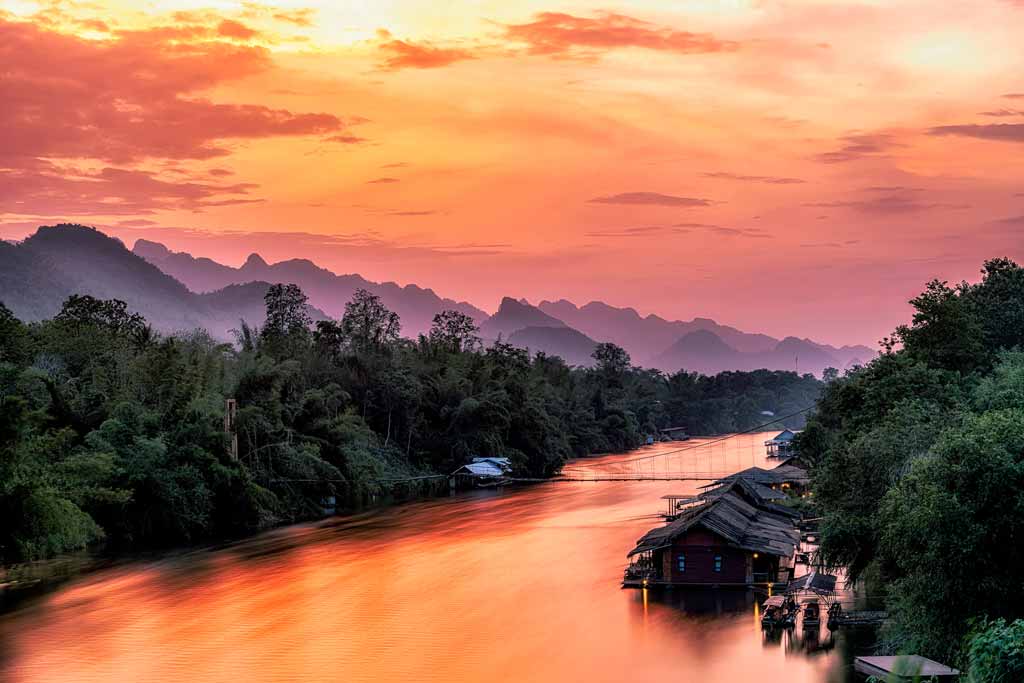
Avoiding Overtourism
Overtourism is when the amount of visitors a place receives reaches a level that is no longer sustainable from an environmental or societal viewpoint.
We’ve dived deeper into overtourism and ways you can combat this in this detailed guide, but we’d like to give some ideas here on how this applies specifically to Thailand. These tricks will help you navigate the tourism industry in a responsible way.
Travel Off the Beaten Path
Rather than spending all your time in the most popular destinations in Thailand, consider visiting places that fewer tourists get to.
For example, Chiang Mai is absolutely incredible and definitely deserves a few days to explore, but when you’re finished here you can visit the lesser-visited Mae Hong Son.
Down in the south get out of Phuket and check out Trang or Koh Mook instead.
The benefits of getting off the beaten path is that you’ll have the chance to spend time in places that not as many international tourists see, and you’ll spread your tourist dollar to communities that really need it.
Local Community Based Tourism in Thailand
Finally in our sustainable tourism in Thailand guide, we will touch on the concept of local community based tourism.
Local community based tourism is where a visitor spends time in a local village and spends their money directly with vendors and small businesses rather than big operators or companies. Putting your energy and money into community based tourism rather than the big tourism industry is a great way to support the locals.
This simple mindset and action when travelling can have tremendous benefits for a local community and economy, and in a country like Thailand it is very easy to do.
Just like getting off the beaten path, we recommend you visit places that don’t see as many tourists and booking accommodation and activities directly with businesses.
You can spend the night in local guesthouses or eat at local restaurants to help inject your money directly into the local communities. There are many ways to try local community based tourism!
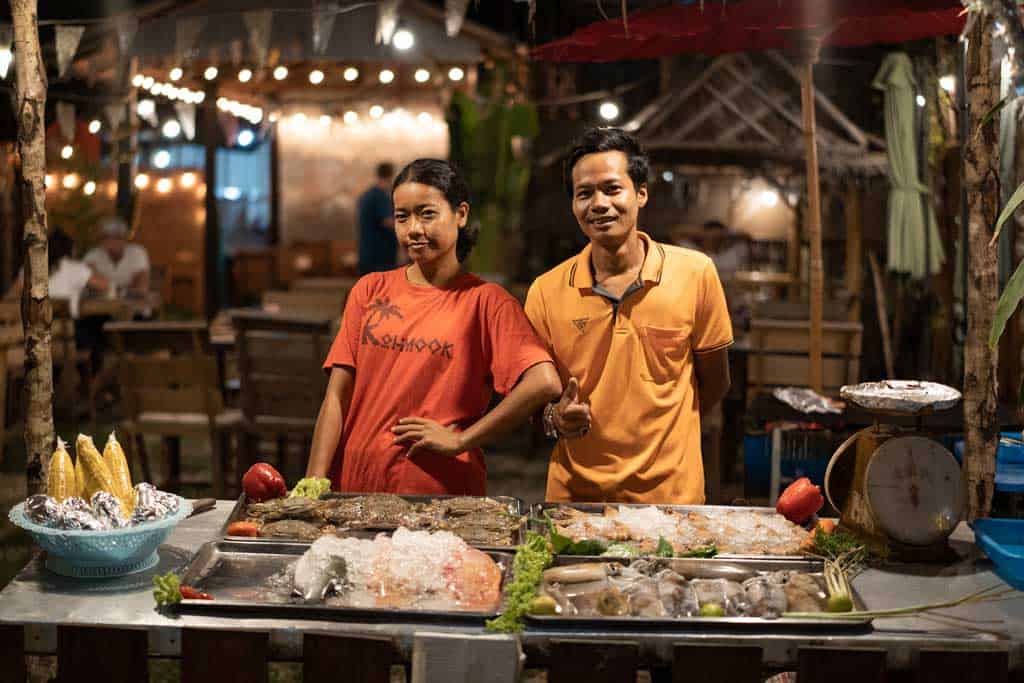


6 thoughts on “Sustainable Tourism in Thailand – Ecotourism, Wildlife and Culture Guide”
As an expat in Thailand with nearly 20 years of residency, I can say with 100% certainty that several
of the ‘sustainable’ activities highlighted in this article are inaccurate and downright false.
Example: Thailand did NOTHING to stop single use plastics. Thousands of vendors, shops, supermarkets and 7-11s hand out single use plastic bags, spoons, containers etc EVERY DAY. Many Thais also burn their plastic waste, including our local district government office.
Trash Hero was abandoned in our local beach community because the amount of trash was overwhelming for a handful of volunteers to deal with. Secondly, most Thais don’t care about the environment. Throwing/burning trash are their normal behaviors. I can go on but I may be sued for defamation because in this region, the truth/facts are the first casualty of a culture that values material monetary things than their own culture/environment. Don’t even get me started on the ‘FAKE’ Buddhism nonsense in Thailand.
thank you for helping me with my school
You are welcome. So glad we could help. 🙂
Thank you so much!!!!!!!!!!!!!!!!!
I loved reading all your sustainable recommendations. I am planning to visit Thailand sometime next year, so this is super useful and informative! The elephant sanctuaries are on my list.
So glad you found the article helpful. It is so important to travel sustainably and know about the tours and the companies that you go with. Hope you have a great trip next year to Thailand. It is an amazing country. Definitely do your research on the elephant sanctuary. They can easily name themselves this but sometimes they are not a sanctuary. There is no one monitoring this in Thailand. Have a good one.